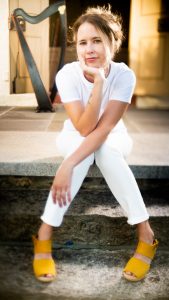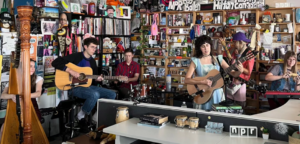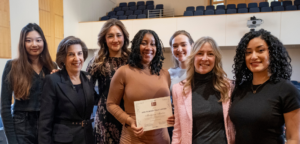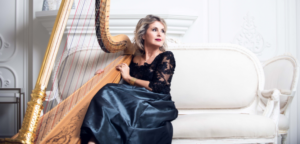Lever harpist and composer Maeve Gilchrist has been making waves for her diverse career performing music influenced by Celtic and folk sounds, electronics, and other improvisatory styles. Her impressive career has led to collaborations with artists such as Viktor Krauss, the Silk Road Ensemble, and Esperanza Spalding. Released Oct. 9, her new album, The Harpweaver, has been billed as “buoyant, sprightly, and utterly beguiling” by Siobhan Long (Irish Times). Below, she shares her thoughts on artistic nostalgia, composing for other instruments, and exactly how this album came to be.
In the album notes, you mention that the album is inspired by “artistic nostalgia.” What do you mean by that?
I’m a firm believe in art’s intangible ability to move people in powerful ways—in its ability to illuminate, heal, and stir feeling in a way that reaches well beyond the most persuasive argument. As a folk musician, I’ve seen people across the globe moved to tears by the music of Scotland and Ireland and feeling emotionally connected to it without necessarily having a literal connection to the country. I feel that there’s a nostalgia inherent in the notes themselves that allows people a cathartic experience through the music. In the melodic material of the Harpweaver, I draw inspiration from a lot of old melodies. Tunes and songs that may have been the sort played in music halls in New York, Boston, and Chicago catering to the Irish immigrant communities. I think that the sentimental nature of these melodies is appealing to people, even when clothed in a more contemporary string context. Regardless of cultural background, I hope these sounds can bring people some joy and comfort during these hard times when it’s more difficult to be with those that we love.
 When talking about the album, you said, “So often as musical technicians, we get preoccupied with mastering the instruments, and we forget how to receive from the instrument as a gift.” Can you talk a bit more about that idea?
When talking about the album, you said, “So often as musical technicians, we get preoccupied with mastering the instruments, and we forget how to receive from the instrument as a gift.” Can you talk a bit more about that idea?
In the world of contemporary string music, whether classical, folk, or jazz, there is too often a focus on the ‘mastery’ or ‘conquering’ of the instrument. I believe that we musicians are simply conduits for the music and if we wield our gifts in the right way, we’ll allow something beautiful to flow out into the world. In Edna St Vincent Millay’s poem “The Ballad of the Harpweaver,” she illuminates the instrument as providing for the player. In a time of need, the protagonist turns to the instrument and ‘weaves’ from the strings clothes to warm her son. On one hand it’s a very sad tale, but on the other it’s a powerfully hopeful poem illuminating the healing power of our instrument, the harp.
I love the string quartet layered into the album. Did you find it easy writing for other instruments?
I started doing more string writing and orchestration a few years ago after the Western Piedmont Orchestra very generously commissioned me and a wonderful NC-based composer Luke Benton, to write a harp concerto for the Celtic harp and full symphony orchestra. This was my first large-scale foray into this world and I think there’s a slightly addictive quality to the sound-palette available to us via strings. It creates a beautiful contrasting foil to the harp. A lot of this material started its life as a solo harp piece as I put together a program that I toured (my first solo tour) in New Zealand in 2018. I was working a lot with strings around that time, doing string arrangements for other people and working on a couple new commissions of my own. It felt organic to weave this wash of sound in and around the harp in the context of this material. I’m an untrained composer/arranger, and it’s been a real learning curve for me in the last five years to take such an unknown path. I think the reason it’s turned out to be successful is that there are very few people currently arranging for strings who come from a folk music background. Having the ‘feel’ of the music in my blood allows me a different lens on the arrangement process and hopefully create arrangements that feel organic and embodying of style and groove.
I thought it was interesting that you incorporated footage of you and your team working in the studio in the music video for the title track. Where did that idea come from?
I love being in the studio! I’m like a kid in a candy shop! I still find it thrilling to be creating in the booth: listening back to impromptu ideas, playing with different microphones, and utilizing vintage amplifiers to find the perfect sound-frame for my instrument. In the process of this particular album, I was often working in real-time: listening back to the string parts, scratching out ideas, and sketching new ones as the day went by. There’s a feeling of suspended time when I’m in the studio and existing purely in my imagination. No emails, no texts, just the manifestation of new sounds!
I saw that this album originated as a Kickstarter project. Will you talk a bit about that process? Any tips for other people trying to get albums out into the world?
Phew! That sure was a process. I’m endlessly grateful for everyone who supported this project and allowed me the funds to create a very ambitious and expensive project. If I’m being completely honest, the experience of creating awareness of the campaign and staying at the forefront of everyone’s inbox and social media intake felt like a full time job. If I did it again I would pre-plan absolutely everything. I would create all social media posts and newsletters in advance so that they don’t take over my day as much. I would pre-record video and photographs to post so I don’t spend time taking selfies or uploading videos! A real learning process. It did feel like a unique way to connect with fans and music-lovers, and it allowed for some correspondence that I don’t believe I would have otherwise had. I’d consider doing it again, but I wouldn’t be flying by the seat of my pants so much! THANK YOU to everyone who chipped in or spread the word. This album simply wouldn’t have happened without you.
Finally, tell us about the harp that you play on; it doesn’t look familiar to me!
I play a Thormahlen Ceili. The Thormahlens are a small harp-making company in Oregon and I just LOVE their Ceili model. I have two and I can wholeheartedly recommend them as versatile, reliable, and very durable instruments for a touring musician. I also recently purchased the new Dusty Strings flight case as a lighter and more maneuverable alternative to the one I had. Once this Covid stuff has had its day, I’m sure looking forward to packing my Ceili into my new case and taking off to play some music for you all!












